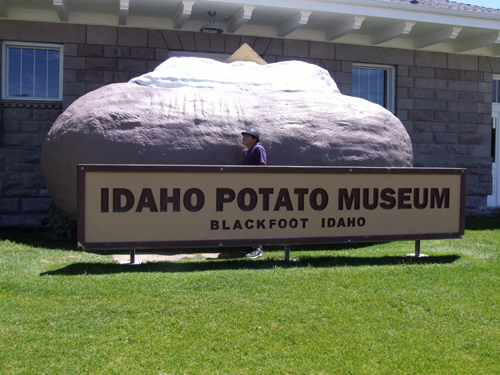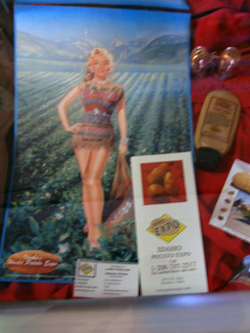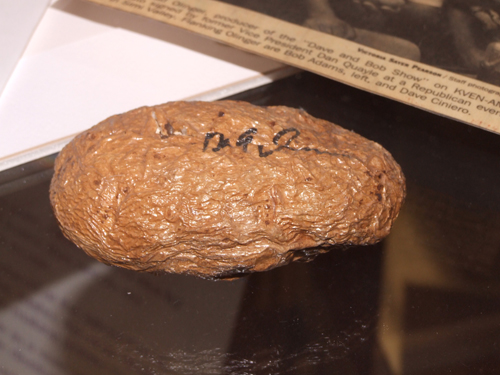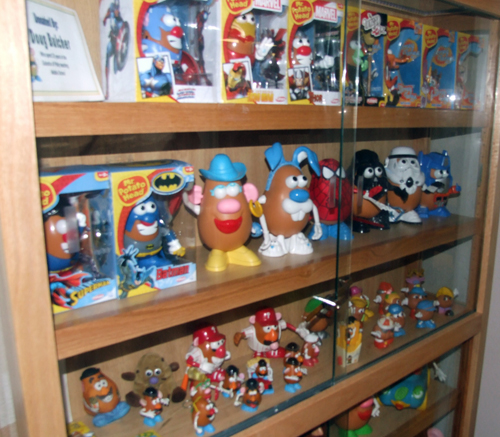
-Twelfth in a Series-
By Donald H. Harrison
 BLACKFOOT, Idaho –About the time that movie star Marilyn Monroe converted to Judaism in association with her marriage to playwright Arthur Miller, potato farmers and marketers in Idaho were talking about how beautiful a woman she was.
BLACKFOOT, Idaho –About the time that movie star Marilyn Monroe converted to Judaism in association with her marriage to playwright Arthur Miller, potato farmers and marketers in Idaho were talking about how beautiful a woman she was.
“She’s the kind of woman who would look good in anything—even a potato sack,” said one. “Say, that’s a brilliant idea,” said another. “Let’s see if we can get her to pose for our advertising campaign.”
They did and she did, producing a memorable image of Monroe in a burlap bag. As was clear to everyone, she was outstanding in her field!
The Monroe image is just one of the exhibits at the Idaho Potato Museum, which shares crowded quarters in a former railroad depot with the Blackfoot Chamber of Commerce.
Here one can learn about the history of the Idaho potatoes, as well as about some of the innovations that have changed the way that potatoes are planted and harvested. There are also interesting potato-based collections, such as postage stamps from around the world featuring potatoes or their lore, an assemblage of Mr. Potato Head toys, and a one-of-a-kind souvenir, a potato signed by former U.S. Vice President Dan Quayle.
Quayle during a 1992 campaign stop in Trenton, N.J., asked William Figueroa, 12, in a demonstration spelling bee, to spell “potato.” Figueroa got it right, but the card Quayle’s staff had prepared for him had another “e” at the end. Quayle suggested to Figueroa that he add an “e” to the word on the blackboard, which Figueroa did politely. But, of course, Figueroa had been right and the vice president wrong – much to the delight of late night talk show hosts and other comics.


My grandson Shor and I had figured wrongly that when we arrived at the potato museum, there might be many kinds of potato dishes to sample. Visions of potato latkes, potato knishes, and vichyssoise filled our heads. However, there were no potato dishes to sample at the museum—only those to look at, including “the world’s largest potato crisp.”
The difference between a potato crisp and a potato chip, explained Tish Dahmen, who does double duty directing the Chamber of Commerce and the Potato Museum, is that a chip is a slice of a potato, whereas a crisp is made by mixing several potatoes.
We asked Dahmen what her personal favorite potato dish is.
She had several.
“My favorite is baked potato with lots of butter,” she said. “It is easy, and except for the butter, it is nutritious.”
“Funeral potatoes” also are popular throughout Idaho, she said.
“The way they got their name was whenever someone went to a funeral or to a shower, someone would bring a dish of potatoes. You take a bag of frozen potatoes, put it in a casserole pan, put either a cream of mushroom or a cream of chicken soup on it, add a little milk, a lot of cheese, sour cream, sprinkle it with crackers or potato chips, then bake it, and it’s fabulous!”
Not kosher, but fabulous. “This is a standard dish here,” she said.
Dahmen said she also likes to make potato salad, and almost everyone has his or her own favorite recipe.
“I like it sweet, so I use sweet pickles instead of dill pickles and I use real cream with my mayonnaise,” she said. “I use dried mustards. And celery to make it crunch, and of course eggs. It is different. My mother in law is German, and her potato salad is a thousand times different from mine. She puts bacon in hers and dill pickles, and it’s a whole different dish.”
It’s not kosher either, I thought quietly to myself.

We toured a room filled with machines for cutting potatoes (you can quarter them and plant them), for digging the holes to drop them in, and for dropping the potatoes from a horse-pulled cart.
Another machine called a “Spudnik” – developed about the same time the Russians put their first Sputnik satellite into space – was a portable conveyer belt, which facilitated the loading of potatoes from cellars into waiting trucks. “It made loading them 1,000 times easier, and helped to explode our industry,” Dahmen told us.
Answering why Idaho has become so famous for potatoes, Dahmen said it resulted from having perfect conditions for growing the Russet potato strain developed in New England by Luther Burbank. “We have short summers, which provide the hot days and cool nights which are best for potatoes,” she said. “The soil on the Snake River Plain is really rich with nutrients plus the volcanic material that is in it. And then, there’s our irrigation. We are not overly wet, and that is a big thing, because potatoes can rot with too much water.”
Blackfoot, she said, was a great place not only to grow potatoes but also to get them to market. “Because of our railroads we were able to ship them all over the world. Today, a lot of the potato crop is trucked out, and the railroad is not as used as much as it was before.”
Which, I suppose, is why the old railroad depot is today a potato museum!
_____________________________________________________________________________________
IF YOU GO: We stayed at the Best Western Blackfoot Inn, just off the Interstate 15 and a short distance from the Idaho Potato Museum. It boasts an indoor swimming pool, free wi-fi, and a complimentary breakfast. Nearby, we had lunch at Rupe’s Burgers, and dinner at Tommy Vaughn’s, which it turned out is owned by the same family that owns Rupe’s. (Even some of the serving personnel were the same). And yes, there were potato side dishes at both eateries.
_____________________________________________________________________________________